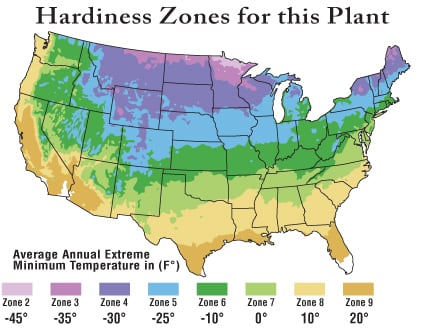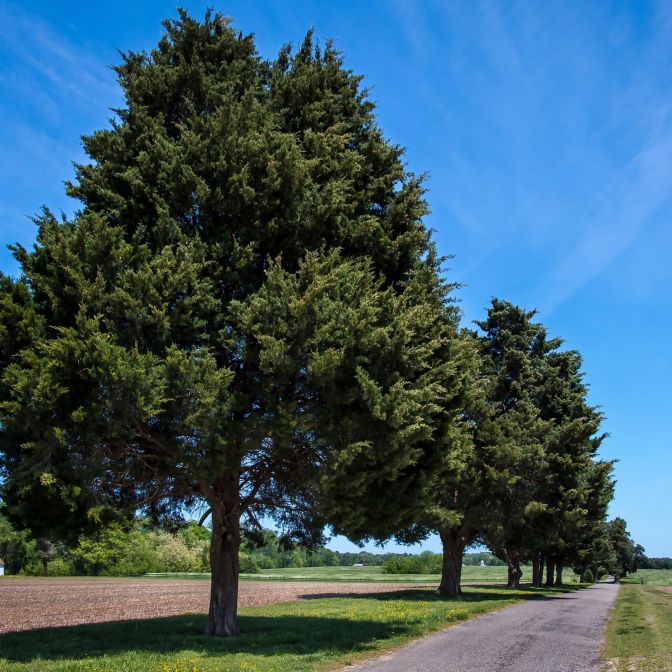Eastern Red Cedar
Plant Type: Dormant, bare-root
Zones: 2-9
Soil Type: Clay, Loamy & Sandy Soils
Site Selection: Full Sun, Partial Sun
Mature Height & Width: 40-50' Height and 8-20' Spread
Growth Rate: Moderate - 12-24" per year once established
Moisture Requirements: Dry to wet soils
Eastern Red Cedar Plugs Also Available - CLICK HERE





Eastern Red Cedar
Juniperus virginiana
The Eastern Red Cedar is an iron man when it comes to trees. If you have a tough spot to fill, this is your tree. This cedar will grow just about anywhere, even in those bottom land and low lying areas of your property. Its dense, blue-green and somewhat prickly foliage is a natural harbor for many types of birds and is deer proof. The Eastern Red Cedar turns a purplish color in autumn and its berries stay on as a food source for many different birds and small mammals.
The Eastern Red Cedar is also sometimes called the Eastern Juniper, Red Juniper or the Pencil Cedar.
The Eastern Red Cedar is sturdy beyond belief once it is established. In the seedling and small tree stage, it needs to be watered vigilantly, sometimes twice weekly if you are experiencing a dry spell. Eastern Red Cedar can benefit from using a root stimulator when it is planted such as Ferti-Lome Root Stimulator & Plant Start Solution®, or something similar.
This plant may benefit from the application of a fungicide. It is intolerant of wet foliage, so watering the soil at the base of the plant is necessary. With that said, the Eastern Red Cedar is prone to mold and/or fungus if the foliage remains wet. After planting, heavy precipitation or long lasting dew may present challenges for the seedlings. If they brown out, it is likely a matter of water lingering on or around the foliage. If heavy or frequent precipitation occurs in your location, this may cause you to experience issues with your Eastern Red Cedar.
The Eastern Red Cedar is about as deer proof as they come so it is a great choice for those areas with heavy deer populations. The dense foliage is used for roosting and nesting cover by many types of game birds, songbirds and several types of raptors.
These plants require a bit of special attention during the first planting season in particular. Eastern Red Cedar requires adequate moisture. During dry spells, it is necessary to provide additional water, (a thorough soaking applied directly at soil level). Eastern Red Cedar does not like wet foliage, especially when they are younger trees. However, they are typically content in wetter soils.
Common uses for the Eastern Red Cedar:
- Evergreen for almost any soil type or moisture situation
- Excellent shelter for game birds, deer and many songbirds
- Privacy screen or living fence
- Naturalizing fields, old fence rows and river or stream banks
- Reddish colored and naturally rot resistant lumber
The Eastern Red Cedar serves as a food and shelter source to many birds and mammals such as White-tailed deer. The berry like cones are eaten by many game birds and songbirds such as the Cedar Waxwing which was named after the tree. Game birds that look to this cedar for food and shelter include the Ruffed Grouse, the Bobwhite Quail and Wild Turkeys. Birds that use the Eastern Red Cedar for food or nesting cover include the Cooper's Hawk, Blue Jay, Robin, Northern Mockingbird as well as some warblers and sparrows. The dense cover also makes it a roosting hangout for many other birds including owls. The berry like seed cones are also eaten by the Gray Fox, Black Bear and the Eastern Chipmunk.





